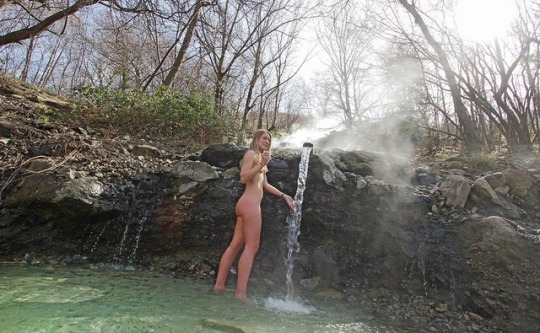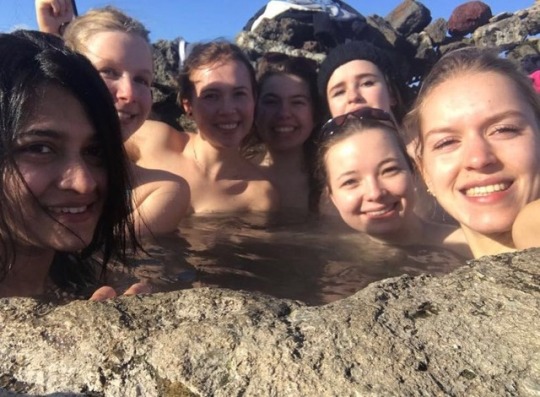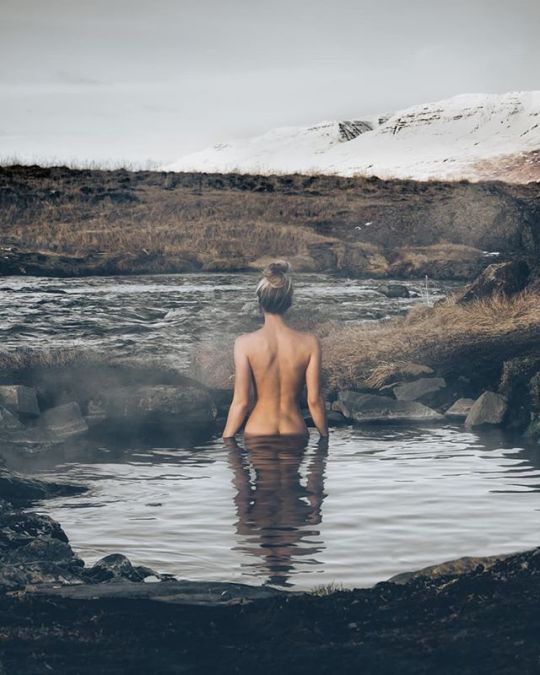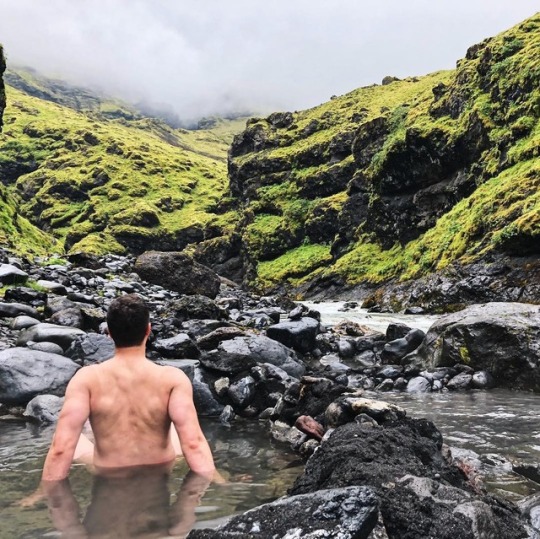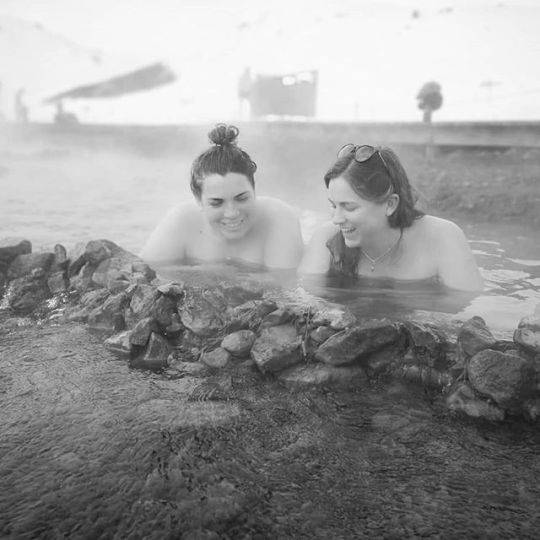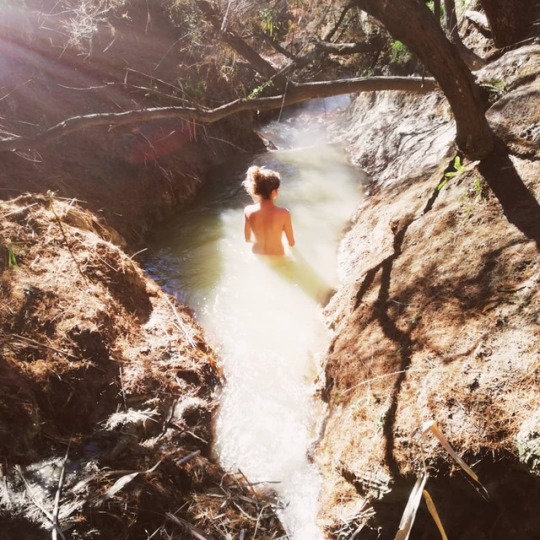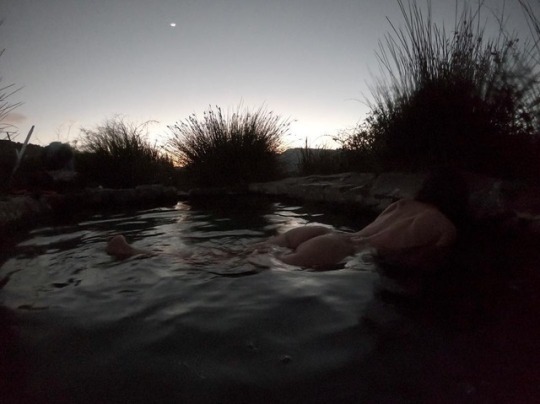Morocco is not the first country that springs to mind when thinking of a soaking sojourn.
And in all honesty, after a two week stay in Morocco's south, it's safe to say it's not really a hot springs haven.
But that need not be. back in 2014 Morocco went to great lengths to host the Global Spa & Wellness Summit, though the emphasis was more on wellness and spa rather than natural hot springs.
Even though, it still resulted in quite a bit of information getting put out. I remember at the time it was quite a thing, however there doesn't seem much info that's been left behind. I did find this pdf file trying to lure guests to visit quite of few of the Kingdom's soaks.
Unfortunately most English oriented soaking researchers will be handicapped, as the lingua franca in which Moroccan hot springs are presented, is French.
E-taqafa.ma is a good staring point. It mentions:
'Le Maroc compte plus de 117 sources thermales, réparties sur six zones thermales : Nord-Est , Rif et Sud-Rif, Centre, Moyen-Atlas, Haut-Atlas, et Anti-Atlas et Sahara. Plus de 50% de ces sources appartiennent à la zone Rifaine et sud-Rifaine.
Sur les 117, seuls 29 sites sont répertoriés, eu égard, carte de situation, composition chimique, pathologies traitées. Et sur les 29 répertoriés, six sites seulement constituent vraiment des établissements thermaux, au sens propre du terme'.
So starting from 117, designating 29 and mentioning 6, there seems a lot has been lost on the way. The six of these "real thermal establishments" are:
- Abaynou (near Guelmim),
- Ain Allah a warm spring near Fes,
- Ain Salama near Meknes,
- Fezouane near Berkane,
- Moulay Yacob, probably the countries better known resort, not too far from Meknes and
- Sidi Hazarem, again not far from Fes.
Cumin
Maybe there's more.
In a previous visit (a long time ago), I had decided to visit Moulay Idriss (not far from the central Moroccan city of Meknes) and the nearby Roman ruins of Voulibilis.
I had heard of a hot springs nearby, but also knew that somehow the town was off-limits; it was also not so convenient that it was Eid, meaning I wasn't lonely heading there.
As everyone streamed into Moulay Idriss, I eventually only got to see the ruins, impressive.
But remembering there had to have been a hot spring, I've looked up some additional info.
The Guardian (Apr. 30, 2011):
'Until
2005, non-Muslims were not permitted to stay overnight in Moulay
Idriss. Guide books warned the tourists who dared to visit to be out of
town by 3pm [so I wasn't mistaken].
...
Other attractions include ancient Roman hot
springs, a 10-minute walk away in the peaceful hills, with two
moderate-sized baths built into the foothills of Mount Zerhoune. You can
swim here: the water smells of cumin and hot stone. (In the summer,
Richardson says, it is "boy soup".)
But times have changed here. The Dar Zerhoune resort seems to be attracting quite a few tourists to the town. Concerning the hot springs they mention:
Thermal Baths:
Moulay
Idriss has a roman bath that is filled with thermal spring water which
is said to have many curative properties, similar to Moulay Yacoub. It
is FREE to use and open all day and night. Now please don’t imagine it
is like going to a municipal swimming pool. It is literally a big bath
tub, about 10 m diameter, there is nowhere to get changed and there is a
‘shack’ for a local café. I recommend you go dressed in what you want
to swim in and enjoy the experience. Even Moroccans from outside of
Moulay Idriss will not believe you about the Roman baths with thermal
spring water so take a photo to prove it is there.

'However, while everyone talks about Volubilis as the must-see thing in
Moulay Idriss, no one ever told us about the other treasures in town!
That’s another reason why Dar Zerhoune and Rose are fabulous. We learnt
about so many other hidden beauties that tourists don’t usually know
about. For instance, Rose led us to a Roman hot spring that was only a
short hike away!'
But you also understand that there's a sort of challenge, why isn't this hot spring not listed? Are there more non-listed hot springs waiting to be discovered?
Steep
Deciding to concentrate on southern Morocco, finding a spring worth a visit proves quite challenging.
I flew into Marrakesh, a grand airport which still seems to need to adapt to the ever increasing numbers of trendy and young people looking for the next big thing (Marrakesh? Really?).
I had spent some time in Marrakech years ago (as above) and though back then the city was very authentic, it was nevertheless not too much to report on. Besides, the lure of the nearby mountains and the desert beyond were (and are) too hard to resist.
This time much of the same.
My research hadn't uncovered any other hot spring near Marrakesh and my best soaking shot was a place called Abaynou (or Abeino), not far from the town of Guelmim, itself bordering on / off the desert. Getting here would be part of the fun, it's more than 400 km's from Marrakech.
Taking a scenic route, we went over the steep Tizi n'Test, past Taroundant into the desert via Tata and then rewarding a beautiful stop at Amtoudi:
From the agadirs and gorge of Amtoudi, we head to Guelmim, through the rocky desert.
Rusty
For some reason I failed to pick up on the hot spring of Fask, despite us passing through the place!
From the I-net and a slight apology for presenting the info in more foreign tongues. Today is a good day (Feb. 27, 2017):
'Danach geht es die wenigen Kilometer Richtung Fask und kurz vorm Ort südlich ab in unbenutztes Terrain. Wir haben GPS Koordinaten und eine grobe Beschreibung wo die Quelle sein soll. Die etlichen Fahrspuren in dieser Einöde können aber schon verwirrend sein. Wir finden auch einige Wasserlöcher vom letzten großen Regen vor wenigen Tagen, sieht aus als haben sich einige Festgefahren. Wir bleiben also zusammen und arbeiten uns vorwärts.
Der Horizont eben und nichts außergewöhnliches zu entdecken, die Quelle auch nicht natürlichen Ursprungs, hier wurde vor Jahren angeblich 800m tief nach Öl gebohrt aber zum Glück nichts gefunden. Das Wasser aus der Quelle kann auch nicht zur Landwirtschaft genutzt werden, fließt also einfach ins Oued ab und bietet Lebensraum für Frösche und Sumpfpflanzen. Wir finden den kleinen Canyon der das Thermalwasser führt und kurz darauf auch das rostige Rohr des Bohrloches wo das heiße Wasser früher mit Fontäne rausspritzte. Heute ein leichtes plätschern und 41°warmes klares Wasser sammelt sich in der Vertiefung drum herum. Die Umgebung bietet an jeder erdenklichen Stelle Stellplätze also ist unser Verbleib für die nächsten Tage besiegelt. Hot Spring Fask, eine weitere heiße Quelle auf meiner Liste. Zeit für Blödeleien und die Busse direkt im Blick.

'The hot spring near Fask in the middle of the desert sounded like the perfect place to work in a relaxed environment. The ride off the road was quite rough and took about 30 minutes.
...
All the effort was worth it! A company drilled for oil a couple of years ago. They didn’t find any oil, though. They hit on hot water which has constantly bubbled out of the ground since then. Some people built a little pool around the spring in which you can take a hot bath for free. Amazing!
'Mittlerweile
im tiefen Süden Marokkos angekommen, möchten wir uns die Natur-Therme
bei Fask, in der Nähe von Guelmim, auf keinen Fall entgehen lassen.
Zirka 10 Kilometer holprig-schlammige Piste müssen wir dazu fahren -
dafür ist dann an der Quelle aber auch deutlich weniger los als in Santa
Fe [Andalucia]: Neben unserer Gruppe steht zunächst nur ein einziger Camper an der
Oase der Wüste.
Cindy & Sönke ganz entspannt - in 40 Grad warmen Wasser
Das
Wasserbecken an sich ist recht klein und vor allem ziemlich flach, das
sprudelnde Thermenwasser dafür mit 40 Grad und nur sehr leichtem
Schwefelgeruch ein echter Luxus. Tagsüber ist’s sowieso warm genug, aber
am Morgen und nach Sonnenuntergang ist das Bad in der Therme eine
willkommene Abwechslung'.
But to sum up, you need the coordinates, it's non natural and it's still off the road (by half an hour). Even if known, my rental Kia would not have made it there. Or back. Then again it would have been a nice find.
Let's now look at the experiences gained. Or not.
Level
The easy part was heading to Guelmim, a place that sounds exotic.
But after the rocky and rather empty desert, Guelmim is suddenly a busy and slightly dusty crossroads. Having come from the rural and beautiful town of Amtoudi, the town is a small shock.
But luckily the hot springs of Abaynou lie beyond Guelmim and it's airfield.
In all honesty, the village of Abaynou is not impressive either; a big dustbowl, as they are repairing the road.
At the end of the only road, it sort of continues with a crossing of a dry stream bed. At this crossing, there's a building just north of the track and one south. A few trees have been planted, so this might be it.
We park.
There are a couple of people picnicking, but I nose around the closed buildings.
For males
Luckily there's a guardien, who speaks a few words of french, very much the same level of understanding as I do.
I deduce that the buildings are indeed the hot springs, north for females and south for males.
But since October 2018 they have been closed for renovation. There is indeed some work equipment nearby.
After establishing that the guardien has the keys to the northern building, we manage to convince him to show us the bath, the ladies bath.
Once inside, there's precious little evidence of any works ongoing, but the buildings though not too old, but definitely do need an upgrade.
There are expansive changing rooms.
The pool itself (see photo above) is slightly lower with what appears murky waters, no smell. The spring still flowing, it looks enticing but the permission to tour doesn't extend to soaking itself.
So a long journey for precious little.
Largesse
What can I find on internet?
Spelt as Abaynou, some info concerns the alternative spelling of Abeino. Or Abbainou.
Some experiences through the times:
'We headed to a thermal bath place called Abeino, where we went to 5 years ago. Reassuringly the same, we headed for the door together. No, I had to go to a second one across the road..segregated. I got changed into my bather in the changing room and wondered if my bather was to scant for the muslim women I was about to be with.
...
They were nearly all naked! Large,enormous,one in bra and pants. None could swim but we all enjoyed the very warm thermal water'.
'Nearby hot springs are channelled into two bath enclosures the ladies being 28C and the men’s 38C. Having realised the potential as a tourist attraction they are working on the mens to modernise it and adding a hammam. Once complete they will start to charge for admission. For now they are offering mixed bathing in the ladies after 7pm with no charge. Setting out to explore we have a pleasant walk strolling through the shady palmery where a canal channels water to the individual allotment type fields. The ladies hot baths leave a bit to be desired. Enclosed by high walls steps lead a long way down to a large tiled pool with stepped sides. The mineral water itself is warm and clean but in many areas green algae is starting to build up on the tiles. Return after 7.00pm guided by the full moon. I wear a T-shirt over my costume so as not to embarrass the Muslims but it also serves a purpose of stopping me feeling the slime if I lean back against the tiles. Soon relax and realise that once you find a clean patch of tiles the whole experience of bathing under the starts is most pleasant – until a man arrives and starts washing his pots in the pool then another to wash clothes. Time to exit before someone comes and empties their toilet as well'.

Then it was 17 km back the way we had come, to the oasis and hot springs at Abbainou (Abeino). It's a tiny oasis with a koubba (tomb of a marabout/holy man or local saint) and hot springs, channelled into 2 baths enclosures - divided according to sex - where you can soak the afternoon away. Actually from 7 pm there is mixed bathing in the male bath, so obviously that was our choice. The temperature in the female is allegedly 28C and the male 10C hotter. We can only attest to the male one which we used that evening and it was gloriously warm, if ill-lit with no changing facilities. 15 Dh pp and you can stay in as long as you like. For us the 90 min we lazed in warm comfort passed in just a moment and we thoroughly enjoyed the experience. At this time of night there were just European couples: French (3), German (2) and us'.
Leaving the experiences behind, here is some more general info. The Rough Guide:
'Abbainou (Abeïno) is a tiny oasis, 15km northeast of Goulimine, and an easy excursion if you have transport (head up the Sidi Ifni road for a kilometre and it’s signposted to the right). If you don’t have a vehicle, you could negotiate a grand taxi (from the main rank by the souk). There are hot springs, which have been tapped, and on cool mornings the irrigation channels through the palmery can be seen steaming. There’s a basic campsite, and a café and bakery in the village centre, but the main interest is the station thérmale at the immaculate Hôtel Abaynou (t 0528 872892; BB 300dh), where two indoor pools have been created, one for women at 28°C, the other for men, at a scalding 38°C'.
Maroc-trip in French:
'Située à 15 km au nord-est de la ville de Guelmim, la source thermale d'Abaynou où la température de l'eau atteint parfois 38°C, présente des vertus curatives notamment en ce qui concerne les maladies dermiques et rhumatismales. Ce qui distingue encore plus cette source, c'est son emplacement au milieu d'une oasis de palmiers et d'oliviers, sur le flanc sud de l'Anti-Atlas occidental. Actuellement, la station dispose de deux bassins, un pour hommes et un pour femmes, des services d'accueil et un hôtel.
On raconte dans la région que dans les années 60 du siècle dernier, un enfant qui souffrait de plusieurs maladies dermatologiques a guéri après avoir pris des bains dans cette source.Un document scientifique du Ministère de la Santé relève que les analyses physico-chimiques menées sur les eaux provenant de la station d'Abaynou ont montré qu'elle recèle des caractéristiques thérapeutiques intéressantes pour le traitement de certaines affections dermiques et maladies rhumatismales, grâce à ses riches composantes tels que le calcium, le magnésium, le sodium, le potassium, le chlorure, le nitrate, le sulfate et le CO2'.

Looklex:
'Despite
an atmosphere of a sanatoria, Abaynou is really meant only to serve its
own villagers. But the bath is still open to anyone, and is easy to
locate with its simple red walls and a little bit of adornment and
obviously the object of local pride'.
And then we get to know that the temperature is 39°C (source).
Abaynou hot springs has a Facebook page, though no mention of the current closure on this.
Unknown
Well, if you are (re-)searching, there's always some more info that pops up. For instance, there's another hot spring attributed to Guelmim region but a lot further away. Maroc-Trip:
'La source thermale
Aïn Lalla Mellouka se trouve dans la commune rurale Aday, à 100
Kilomètres de Guelmim. L’eau de cette source présente des vertus
curatives notamment en ce qui concerne les maladies dermiques et
rhumatismales'.
Though there's little more than similar references. There is a village of Aday, to the northwest of Guelmim, 50-80 kms rather than the mentioned 100. Then there's this website that indicates Lalla Mellouka is towards the east!
Other related, but real life experiences I had, was what proved to be an elusive search for the Ain Skhouna hot spring. My source of info:
'A source of hot water almost unknown to tourists and locals. The village of Ain Skhouna, a few kilometres from the city of Agadir, contains a wonderfurl source of hot water, ideal for pain in joints and muscles'.
It came complete with GPS coordinates.
Armed with these, we ended in a non-descript field, no evidence of hot spring past or present:
There does seem a line of inquiry which indicates a different location, one north of Agadir rather.
Discovery
Well, this article is becoming somewhat lengthy. And we're not there yet.
While on the subject of Morocco, let's discuss the local bathhouse, better known as the hammam.
The word hammam conjures up romantic images of oriental and luxury bathing lounges. But that's not quite what you should expect when signing up for a hammam.
In the last century when I previously visited Morocco, I had the pleasure of using a couple of local hammams. Usually non-descript from the outside, you enter the reception area, paid a fee and shifted towards the dark changing area.
On the male side users stripped to their undies and proceeded with buckets towards the bathing area.
Inside what could be best described as a large room, are a number of taps gushing with hot water, while the floors are also heated creating a damp and steamy environment. Patrons are busily washing themselves and chatting away. But essentially it's your neighbourhood bathhouse, the luxury of having one's own beyond the limits of most.
However times have changed.
What's described above still exists. Though now with the influx of tourists and the emancipation of Morocco's own elite, the notion of a hammam has gone upmarket. Basically any wellness treatment you would require is available, but what's understood as hammam is not what it was.
While in Essaouira we signed up for a treatment. At the Azur Spa.
His/hers treatments are available.
Change into flimsy throw away undergarments, have a shower with these on, then proceed to a sweat room, much similar to what's understood as a Turkish steam bath. 10-15 minutes here and you're requested to move to a different room with stone tables. You lie here and an assistant scrubs you in and rinses you. And you are finished.
Some more experiences:
'What Is a Moroccan Hammam Spa?
Moroccan hammams are part of many Moroccans’ daily life. Similar to a Turkish bath, a public hammam is a steam room where people go to clean themselves. This is usually a weekly ritual and is considered a social activity in villages and towns, with men, women, and children all participating. Baths are separated by gender and many people will spend hours here chatting with friends. While in Islamic culture women are typically covered from head to toe in public, they’re fully naked at hammams'.
Includes a good description of what I experienced.
More on the not so local experience.
Enlightenment:
'The word hammam means “the spreader of warmth” in Arabic. This is telling because essentially a hammam is getting scrubbed down/cleansed in a very warm room. A hammam is predicated on the idea of having places of extreme cleanliness – where purifying the body goes hand-in-hand with purifying the soul. And around 600 AD, hammams also became places where major life events were celebrated and bathing rituals incorporated into weddings and births.
Of course this summing up of lists is far from exhaustive, it can go on and on, but this should suffice for this entry. Morocco's hammams are another traditional wellness method well worth a try. But not so natural.
